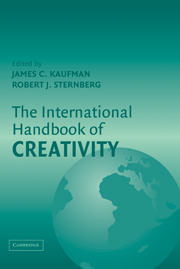Book contents
- Frontmatter
- Contents
- Acknowledgments
- List of Contributors
- 1 Introduction
- 2 Creativity Research in English-Speaking Countries
- 3 Creativity in Latin America
- 4 History of Creativity in Spain
- 5 Past, Present, and Future Perspectives on Creativity in France and French-Speaking Switzerland
- 6 Creativity in Italy
- 7 Creativity Research in German-Speaking Countries
- 8 Creativity Under the Northern Lights
- 9 Creativity in Soviet–Russian Psychology
- 10 Creativity Studies in Poland
- 11 Research on Creativity in Israel
- 12 Creativity in Turkey and Turkish-Speaking Countries
- 13 Development of Creativity Research in Chinese Societies
- 14 Creativity – A Sudden Rising Star in Korea
- 15 Culture and Facets of Creativity
- 16 African Perspectives on Creativity
- 17 Creativity Around the World in 80 Ways … but with One Destination
- Author Index
- Subject Index
- References
9 - Creativity in Soviet–Russian Psychology
Published online by Cambridge University Press: 05 June 2012
- Frontmatter
- Contents
- Acknowledgments
- List of Contributors
- 1 Introduction
- 2 Creativity Research in English-Speaking Countries
- 3 Creativity in Latin America
- 4 History of Creativity in Spain
- 5 Past, Present, and Future Perspectives on Creativity in France and French-Speaking Switzerland
- 6 Creativity in Italy
- 7 Creativity Research in German-Speaking Countries
- 8 Creativity Under the Northern Lights
- 9 Creativity in Soviet–Russian Psychology
- 10 Creativity Studies in Poland
- 11 Research on Creativity in Israel
- 12 Creativity in Turkey and Turkish-Speaking Countries
- 13 Development of Creativity Research in Chinese Societies
- 14 Creativity – A Sudden Rising Star in Korea
- 15 Culture and Facets of Creativity
- 16 African Perspectives on Creativity
- 17 Creativity Around the World in 80 Ways … but with One Destination
- Author Index
- Subject Index
- References
Summary
INTRODUCTION
In this chapter we present an overview of creativity in Soviet–Russian psychology. We are using the term Soviet–Russian psychology to indicate that the content of this chapter is based primarily on studies and conceptions developed in the context of Soviet psychology prior to December 1991, when the Soviet Union was disassembled, as well as on studies and theories that have appeared more recently in Russia. This chapter shows an existing mosaic of approaches to creativity in Soviet–Russian psychology. We present original conceptual and methodological solutions to questions on the nature of creativity and ways to study, and we discuss similarities and common characteristics of these solutions with Western psychological tradition.
With all its richness and diversity, the field of Soviet–Russian psychology of creativity can be understood as reflecting two major trajectories. The first trajectory can be traced back to conceptualizations of insight and creative process in Gestalt psychology (Duncker, 1945; Wertheimer, 1959). Soviet–Russian psychologists, attempting to understand this work, reinterpreted and reconceptualized creative process by implementing general principals of Marxist psychology developed, by that time, in the area of the psychology of thinking (see Grigorenko, Ruzgis, & Sternberg, 1997). The intention was to demystify insight by finding its concrete psychological mechanisms and the objective environmental conditions that lead to its occurrence, and, further, to explain creative processes from deterministic positions.
The second trajectory can be traced to the acquaintance of Soviet– Russian psychological thought with Guilford's view of creativity and with the Guilford and Torrance tests of creativity.
- Type
- Chapter
- Information
- The International Handbook of Creativity , pp. 235 - 269Publisher: Cambridge University PressPrint publication year: 2006
References
- 5
- Cited by



